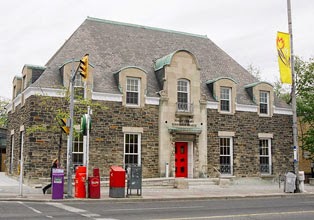
 Presumably we dress ourselves on our own accord,
perhaps preoccupied by taste and weather. But it is all informed by outside
sources – we must buy our clothes from somewhere. Someone must design the
clothing, someone must create it, and someone must distribute it. Appearance
(dress, attitude, movement etc.) can be seen as a form of self-representation.
The focus here is on the surface. Postmodern notions see the surface as an
important site to decipher meaning and negotiate identity. The majority of my
people-watching experience occurs on my commute to school. Buses and subways
are plastered with uninteresting ads, and yet passengers become enthralled in
staring at them in order to avoid looking at (or being caught looking at)
fellow passengers. Phones are another thing passengers stare at during their
ride to avoid one another or any potential awkwardness. The effects of a panopticon
culture can be witnessed here, in this self-regulation in public space. The way
passengers sit is gendered: women tend to take up much less space compared to
male travellers. This is informed by gender inequality, more so than size and
physical need for space. Younger, teenage passengers tend to dress very
similarly to one another: girls often wearing leggings with a comfortable boot,
and boys wearing sneakers and a cap. When the teenagers are in a group they are
much more open about having a conversation and speak more loudly than when they
are alone or with one other person. Passengers with activist pins attached to
their bags, or laptops tend to exit at York University on my particular bus route.
Increasing popularity and use of mobile devices, I would argue, contribute to
this panopticon culture. At any time someone could take a photo or video of you
and upload it onto the internet. In my observation, people regulate their
behaviour in public as if they are under constant surveillance. This notion is
not new, but it is interesting especially considering the increasing means of
surveillance available to a vast amount of people.
Presumably we dress ourselves on our own accord,
perhaps preoccupied by taste and weather. But it is all informed by outside
sources – we must buy our clothes from somewhere. Someone must design the
clothing, someone must create it, and someone must distribute it. Appearance
(dress, attitude, movement etc.) can be seen as a form of self-representation.
The focus here is on the surface. Postmodern notions see the surface as an
important site to decipher meaning and negotiate identity. The majority of my
people-watching experience occurs on my commute to school. Buses and subways
are plastered with uninteresting ads, and yet passengers become enthralled in
staring at them in order to avoid looking at (or being caught looking at)
fellow passengers. Phones are another thing passengers stare at during their
ride to avoid one another or any potential awkwardness. The effects of a panopticon
culture can be witnessed here, in this self-regulation in public space. The way
passengers sit is gendered: women tend to take up much less space compared to
male travellers. This is informed by gender inequality, more so than size and
physical need for space. Younger, teenage passengers tend to dress very
similarly to one another: girls often wearing leggings with a comfortable boot,
and boys wearing sneakers and a cap. When the teenagers are in a group they are
much more open about having a conversation and speak more loudly than when they
are alone or with one other person. Passengers with activist pins attached to
their bags, or laptops tend to exit at York University on my particular bus route.
Increasing popularity and use of mobile devices, I would argue, contribute to
this panopticon culture. At any time someone could take a photo or video of you
and upload it onto the internet. In my observation, people regulate their
behaviour in public as if they are under constant surveillance. This notion is
not new, but it is interesting especially considering the increasing means of
surveillance available to a vast amount of people.













